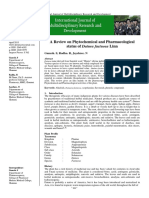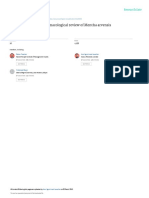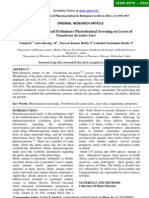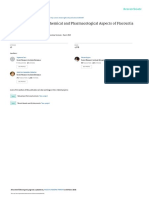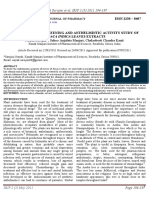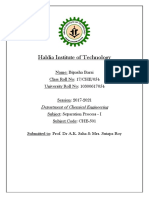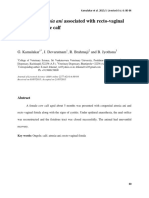DF 1
DF 1
Uploaded by
Rohit KapseCopyright:
Available Formats
DF 1
DF 1
Uploaded by
Rohit KapseCopyright
Available Formats
Share this document
Did you find this document useful?
Is this content inappropriate?
Copyright:
Available Formats
DF 1
DF 1
Uploaded by
Rohit KapseCopyright:
Available Formats
American Journal of Pharmacology Research Article
Published: 19 Apr, 2021
Phytochemical Study and Pharmacological Effects of
Dolichandrone falcata Seem
Rahul Nimba Patil*, Krishnamurthy and Shete RV
Rajgad Dnyanpeeth’s College of Pharmacy, Bhor, India
Abstract
Dolichandrone falcata Seem synonym Markhamia falcata belonging to family Bignoniaceae.
Malawi, Tanzania, South Africa, and India are all home to the vine. Rajputana, Bundelkhand, Bihar,
Deccan, Mysore, and Maharashtra are among the Indian states where it can be found. The plant
is mainly used for diabetes, anti-inflammatory, anxiolytic, analgesic, antiestrogenic, antimicrobial,
antinociceptive, antibacterial, and immunomodulatory activities. The leaves are also used in the
treat of leukemia and menorrhagia. Dolichandrone falcata Seem contains alkaloids, flavonoids,
sugars, saponins, phenolic, terpenoids, cardiac glycosides, steroids, and amino acids. Therefore, this
survey conducted, present was aimed to study the phytochemical study and pharmacological effects
of Dolichandrone falcata Seem.
Keywords: Dolichandrone falcata; Markhamia falcata Bignoniaceae; Medhshing; Mesasinghi
Taxonomical Classification
Common name: Medhshingi, Meshsa-sringi
Synonym: Bignonia falcata, Bignonia spathacea, Markhamia falcata
Biological source: It is a small dediduous tree.
Family: Bignoniaceae
Kingdom: Plantae
Order: Lamiales
OPEN ACCESS
Clade: Tracheophytes
*Correspondence:
Rahul Nimba Patil, Rajgad Clade: Eudicots
Dnyanpeeth’s College of Pharmacy,
Clade: Asterids
Bhor, Pune 412206, India, Tel:
9403058452; Genus: Dolichandrone
E-mail: patilrahul4254@gmail.com Species: D. falcata
Received Date: 10 Mar 2021
Accepted Date: 14 Apr 2021 Parts of plant used: Leave, fruit, root, bark, flower
Published Date: 19 Apr 2021 Geographical region: Rajasthan, Maharashtra, Karnataka
Citation:
System of medicine used in: folk medicine, ayurveda, siddha, sowa-rigpa
Patil RN, Krishnamurthy, Shete
RV. Phytochemical Study and Substance class: Structurally diverse
Pharmacological Effects of Source: Organism
Dolichandrone falcata Seem. Am J
Pharmacol. 2021; 4(1): 1032. Source material type: Plant
Copyright © 2021 Rahul Nimba Author: (Wall. Ex DC.) SEEM
Patil. This is an open access article
Record UNII: 63NASODX3B
distributed under the Creative
Commons Attribution License, which Record status: Validated
permits unrestricted use, distribution, Introduction
and reproduction in any medium,
provided the original work is properly Dolichandrone falcata Seem synonym (Markhamia falcata) belonging to Bignoniaceae [1-3].
cited. The plant is also called ‘medhshingi’ in Hindi and ‘mesasinghi’ in Sanskrit [1-3]. In Ayurveda it is
Remedy Publications LLC. 1 2021 | Volume 4 | Issue 1 | Article 1032
Rahul Nimba Patil, et al., American Journal of Pharmacology
also used as mesha-shringi [1-3]. Dolichandrone falcata Seem has a parenchymas tissues showed a 9 to 12-layer present at the lower side
long history of use by indigenous and tribal peoples all over the world, having a polygonal shape. Patches of sclerenchymas cells measuring
including India, for medicinal purposes and various pharmacological 10 to 15 × 10 to 15 micrometres were found on the vascular bundle's
effects [1-3]. The medicinal value of leaves and bark is also mentioned outer side. The vascular bundle was arranged in a ring of xylem with
in Ayurveda as meshsa-sringhi [1,2]. The bark decoction is also given phloem surrounding it [1].
in the treatment of nodules [4]. For the treatment of antidote leaves
Crude drug extraction
juice is taken orally [4]. The plant is used to treat liver disorders and
anti-snake venom activity [5]. In Ayurveda Dolichandrone falcata Aerial parts of Dolichnadrone falcata Seem were washed and shade
Seem is used as mesh-shingi for madhuka bite also used as Rasayana dried at room temperature and powdered in the domestic mixer. The
drugs [5]. An aqueous extract of the fruit is used for abortion and coarsely powdered drug was extracted in soxhlet extraction different
bark is used as a fish poison [6]. Infusion of powder is given internally solvent methanol, alcohol, ethylacetate, water, acetone extract, and
in the treatment of acute rheumatism [7]. The bark paste is applied petroleum ether extract. The extracts were concentrated in a rotary
for bone fractures and fruit paste for scorpion [2,3,8]. Leaves are evaporator under vacuum and stored at 2°C to 4°C in the refrigerator.
also used for scrub swelling [2,3,6]. In Ayurveda, the stem bark of Phytochemical screening
Dolichandrone falcata Seem is used to cure ulcers, pain, and epilepsy. 2.0 gm of plant extract was dissolved in 10 ml double D/W and
Menorrhagia and leucorrhea are treated with bark juice [2,3,6]. filtered with Whatman filter paper, as defined in standard reference
Material and Methods books with a minor modification, and then used for phytochemical
screening [9].
Plant Collection and authentication
Physical characteristics
Plant Dolichandrone falcata Seem aerial parts were collected from
Savitribai Phule Pune University, Ganeshkhind Pune. The herbarium The preliminary phytochemical screening of leaf extracts reveals
was produced and authenticated in the botanical survey of India, that alkaloids are present in petroleum ether, ethanol, and water
Pune. extract. Saponins glycosides, flavonoids, ethanol and water extract
also contain carbohydrates and proteins. Petroleum ether extract
Morphology
contains oils and steroids [10].
Dolichandrone falcata Seem synonym Markhamia falcata
belonging to family Bignoniaceae. It is medium size tree 0.15 cm high The presence of alkaloids in methanol, alcohol, and ethyl acetate
with dense foliate and profuse flowering. It is highly scented, creamish extracts is revealed by preliminary phytochemical screening of bark
white flowers it is highly scented, creamish white flowers bloom in extracts. Saponins are present in aqueous and alcohol extract. The
the evening and falls in the morning ripe fruits of the previous year terpenoids are obtained in aqueous, methanol, acetone, and ethyl
remain on the tree when the flowers of next year are in bloom. Leaflets acetate extracts. Tannins are found in aqueous, methanol, alcohol,
are opposite, 1.3 to 3.8 by 1.1 cm to 3.8 cm, suborbicular or obovate, and ethyl acetate extracts. Steroids are absent in all extracts. Cardiac
punscent or glabrous, base cuneate or rounded, generally unequal- glycosides are present in all extracts except water. Flavonoids are
sided, main nerves around pairs, prominent beneath; petiolules of found in aqueous, methanol, alcohol, and acetone extracts [10]. The
lateral leaflets 0-w.5 mm long. Flowers in terminal few-flowered presence of alkaloids in methanol and alcohol extracts is revealed
racemes; pedicels 1.3 cm long. Calyx is pubescent and has a short stout by preliminary phytochemical screening of fruit extracts. Aqueous,
mucro at the apex. Corolla white, 2.5 cm long or longer; tube very tobacco, and ethyl acetate extracts all contain saponins. Aqueous
narrow at the base, about 2.5 mm wide, gradually widening upwards; and ethyl acetate extracts also contained terpenoids. Tannins can
limb lobes obovate oblong with crisped undulate margins. Flat, falcate be extracted from plants using methanol, alcohol, or ethyl acetate
curved capsules, 25 cm to 45 cm long by 2 cm high, glabrous. Seeds extracts. Methanol and acetone extract both contain steroid
are rectangular and winged at both ends, measuring 2.5 cm long by 6 compounds. Except for water, all extracts contain cardiac glycosides.
mm wide. The bark is dark brown in color and very high in length. It Aqueous, methanol, and acetone extracts all contain flavonoids [10].
is cylindrical and used as the treatment of fish poison and snake bite. Medicinal Uses
The bhil tribes of Rajasthan use a bark decoction to treat nodules. It is
the most powerful part of the plant [1]. 1. The plant has numerous medicinal uses like antiallergic, anti-
inflammatory, antioxidant, antiestrogenic, anxiolytic, anticonvulsant,
Microscopy antiparasitic [2-4].
The epidermis lined with cuticle was visible in the transverse
2. The plant is also used in curing anemia, bloody diarrhea,
section of a Dolichandrone falcata Seem leaflet. A dorsiventral
anthelmintic, analgesic, antiviral, and antifungal agents [2-4].
structure was visible in the transverse region. The epidermal cell was
observed in a single layer covered with a thick cuticle. Unicellular 3. The plant is used to treat snake venom and also used in the
trichomes interrupted the epidermis. Amphistomatic stomata is treatment of liver disorder [2-4].
included in anomocytic stomata. The cuticle upper epidermis was
Pharmacological Actions
made up of spherical cells measuring 15 to 22 22 to 30 micrometers
in diameter. Spherical cells measuring 15 to 22 22 to 30 micrometers Anxiolytic
in diameter made up the cuticle upper epidermis. Palisade cells and Anxiolytic effects were studied by elevate pulse maze test and
spongy tissues are present in the mesophyll. Palisade cells were thin- marble burying test assay in animals. The DFBM and DFBEA crude
walled elongated cells with a diameter of 22 to 30 52 to 220 micrometers dried extracts were prepared in doses of 100, 200, and 400 mg/kg,
that were found just beneath the upper and lower epidermis in respectively, and the DFB compound was prepared in doses of 50,
a single layer just beneath the upper and lower epidermis. Spongy 100, and 200 mg/kg and administered orally to mice for anxiolytic
Remedy Publications LLC. 2 2021 | Volume 4 | Issue 1 | Article 1032
Rahul Nimba Patil, et al., American Journal of Pharmacology
activity evaluation various Dolichandrone falcata extracts and isolated extracts [14].
compounds The stem-bark extract appeared to have substantial
Antifertility
anxiolytic effects, while the DFBA extract had extremely significant
activities [8]. The present study was undertaken to analyze the antifertility
and estrous cycle effect of Dolichandrone falcata Seem leaves. The
Antioxidant alcoholic and aqueous leaf extracts had a high abortifacient effect at
The aqueous extract of Dolichandrone falcata Seem to possess doses of 200 mg/kg and 400 mg/kg body weight, respectively. The
significant antioxidant activity when investigated by using the DPPH leaf extract of Dolichandrone falcate Seem was found to significantly
scavenging test and reducing powder method. Chrysin found in plant prolong the estrous cycle, especially the diestrous period [15].
have shown to have antioxidant in laboratory animals [11].
Hepatoprotective
Antimicrobial The hepatoprotective function of an aqueous extract of
Pseudomonas aeruginosa, Bacillus subtilis, Candida albicans, Dolichandrone falcata Seem's stem-bark against a Carbon Tetra
Vibrio cholerae, and Salmonella typhi were tested in an antimicrobial Chloride-intoxicated hepatitis model. At doses of 200 mg/kg and 400
assay using Dolichandrone falcata Seem leaf, fruit, and bark extracts. mg/kg of aqueous extract, CCL4 caused a P=0.01 increase in serum
The fruit extract is active against Vibrio cholerae, Candida albicans, SGOT, SGPT activity, and bilirubin level, indicating hepatotoxicity to
and Pseudomonas aeruginosa, but not against Salmonella typhi and be able to afford aqueous extract of Dolichandrone falcata stem-bark
Bacillus Albicans, according to the findings. Salmonella typhi, Vibrio Seem [16].
cholera, Candida albicans, and Pseudomonas aeruginosa were all killed
by the bark extract, but Bacillus subtilis was not. Only Salmonella
Conclusion
typhi and Candida albicans are susceptible to the leaf extracts. Except It can be concluded that with its vast and diversified phytochemical
for Bacillus subtilis, the fruit and bark extract demonstrates a strong constituents and pharmacological potentials Dolichandrone falcata
zone of inhibition against all test species [10]. Seem has a strong future in the world market. The plants are now well-
acclimatized in different parts of the country and enjoy the strong
Anti-inflammatory
export potential for the phytochemical constituent extracted from
Carrageenan-induced paw animal models were used to test the them. The plant scope for its diversified pharmacological activities.
anti-inflammatory effects of methanol and ethyl acetate extracts of
Dolichandrone falcata Seem fruits. Both extracts were used to make References
formulations that were tested in anti-inflammatory assays at doses of 1. Aher N, Chaudhri S, Zalte A. Morphological and Microscopical Studies
100, 200, and 400 mg/kg. The findings show that the extracts have a and phytochemical analysis of Markhamia falcata (Seem). Res J of Pharma
substantial anti-inflammatory effect [12]. and Technol. 2020;13(3):1117-20.
Antinociceptive 2. The wealth of India. A dictionary of Indian Raw Material and Industrial
products. D-E, NISCAIR, CSIR, New Delhi, India. 2006;3:100-1.
Methanol and ethyl acetate extracts of Dolichandrone falcata
have antinociceptive efficacy. Animal models tend to bear fruit. 3. Sulekha J, Gupta V, Sharma U. Phytochemical screening of medicinal
The crude extract was used to make formulations that were tested plant dolichandrone falcata. An Int J. 2016;8(1):215-20.
in antinociceptive assays at doses of 100, 200, and 400 mg/kg. The 4. Nandkarni A, Nandkarni K. Indian Material Medica: with Ayurvedic,
findings show that the extracts have potent antinociceptive properties Unani-Tibbi, Siddha, Alopathic, homeopathic, Naturopathic and Home
that are dose-dependent. The highest level of achievement [12]. Remedies, Appendics and Indexes. Popular Prakashan (P) Ltd., Mumbai,
India. 2002;3(1):751-3,875.
Anti-diabetic
5. Gnanavendhan S. Antisnake venom botanicals from Ethno-medicine.
The anti-diabetic efficacy of Dolichandrone falcata Seem extracts Emmanuel Selvanayagam, Forensic Sciences Department, Madras.
were investigated pharmacologically by measuring blood glucose 2004;7:19-23.
levels in rats. The anti-diabetic efficacy of the extract was investigated
6. Kirtikar K, Basu B. Indian Medicinal Plants, International Book
in rats using low doses of 200 mg/kg, medium doses of 400 mg/kg,
Distributors, Dehradun, India. 1999;2(3):1123-5,1985-7.
and high doses of 600 mg/kg. Glibenclamide 10 mg/kg body weight
was used as a standard guide for anti-diabetic activity against alloxan- 7. Pawar D, Nasreen S. Phytochemical screening and antifungal activity
of bauhinia racemosa and dolichandrone falcata. Int J of Applied Res.
induced diabetes. In diabetic rats, the aqueous extract significantly
2016;2(8):243-5.
reduced blood glucose levels. It was discovered that the anti-diabetic
activity was substantial and dose dependent [13]. 8. Badgujar V, Surana S. Anxiolytic effects of dolichandrone falcata seem.,
Bignoniaceae, stem-bark in elevated pius maze and marble burying test on
Antimycobacterial mice. Revista Brasileira de Farmacognosia. 2010;2(5):0102-695X.
The antibacterial efficacy of Dolichandrone falcata aqueous 9. WHO. Quality control methods for medicinal plant material. Geneva,
and alcoholic extracts the MDR isolates DKU-156 and JAL-1236 WHO 1998.
of Mycobacterium tuberculosis, as well as the reference susceptible
10. Patil J, Biradar S. Preliminary phytohemical screening and antimicrobial
strain Mycobacterium tuberculosis H37Rv and the fast-growing activity of dolichandrone falcata seem. Ind J of Plants Sci. 20132(1):2319-
mycobacterial pathogen M. fortuitum, were tested against Seem 3824.
stem bark and leaves. The antimicrobial assays were performed using
11. Jebakumar A, Zahram E, Nondo H. DPPH scavenging and reducing power
Lowenstein Jensen medium and Middlebrook 7H9 broth in the
analysis of aqueous extract of dolichandrone falcata stem-bark. Int J of
BACT/ALERT 3D process. The results of this study clearly showed Curr Pharmac Clin Res. 2014;4(2):129-31.
that the aqueous extract of stem bark was effective as compared to
aqueous and leaf extracts, as well as alcoholic stem bark and leaf 12. Badgujar V, Surana S, Badgujar S. Anti-inflammatory and Antinociceptive
Remedy Publications LLC. 3 2021 | Volume 4 | Issue 1 | Article 1032
Rahul Nimba Patil, et al., American Journal of Pharmacology
Effects of Dolichandrone falcata fruit extracts in animal models. Entomol 15. Vikhe M, Zade V, Dabhadkar D, Pare S. Antifertility effect of alcoholic and
Appl Sci Lett. 2016;3(5):189-95. aqueous extracts of dolichandrone falcata leaves on estrous cycle of female
albino rats. Int J Pharma Pharmaceu Sci. 2012;4(3):0975-1491.
13. Mungle A, Bodhankar M, Chandak k. Antidiabetic potential of
dolichandrone falcata leaves in alloxan induced diabetes rats. Int J Res 16. Sharma S, Sriram N. Hepatoprotective activity of aqueous extract of stem-
Pharma Biomed Sci. 2012;3(1):2229-3701. bark of dolichandrone falcata in carbon tetra chloride intoxicated albino
rats. Int J Pharmacol Res. 2014;4(2):121-3.
14. Agrawal M, Chauhan S. Anti-mycobacterial potential of dolichandrone
falcata seem. (Bignoniaceae). Medicinal Plants- Int J Phytomed Related
Industries. 2015;7(3):219-26.
Remedy Publications LLC. 4 2021 | Volume 4 | Issue 1 | Article 1032
You might also like
- Chevron Safety HandbookDocument186 pagesChevron Safety HandbookIbrahim Adan100% (5)
- Components of Blood ChartAnemia FlowchartDocument1 pageComponents of Blood ChartAnemia Flowchartivankcurry100% (1)
- Module VenturiDocument46 pagesModule VenturiJeline LunaNo ratings yet
- Semecarpus Anacardium: A Potential Ethnomedicinal Plant: Linn. - A ReviewDocument9 pagesSemecarpus Anacardium: A Potential Ethnomedicinal Plant: Linn. - A ReviewMuhammad NadeemNo ratings yet
- AlalalalaDocument11 pagesAlalalalaCookie JarNo ratings yet
- Review On Maranta Arundinacea L. (Marantacea) : July 2021Document5 pagesReview On Maranta Arundinacea L. (Marantacea) : July 2021Yuey ManguiatNo ratings yet
- 45 PDFDocument4 pages45 PDFZakiya BegumNo ratings yet
- 45 PDFDocument4 pages45 PDFZakiya BegumNo ratings yet
- 2728 - PDF NannariDocument8 pages2728 - PDF NannariSurendra BurneniNo ratings yet
- Maranta ArundinaceaDocument4 pagesMaranta ArundinaceaNOWFA FIROSNo ratings yet
- Insulin Plant - A Review On Insulin Plant Costus Igneus NakDocument6 pagesInsulin Plant - A Review On Insulin Plant Costus Igneus NakAmabel JameroNo ratings yet
- Phytochemical Analysis of Dodonaea Angustifolia Plant ExtractsDocument7 pagesPhytochemical Analysis of Dodonaea Angustifolia Plant ExtractsAnthonyNo ratings yet
- Ijaresm MPKRDBDocument6 pagesIjaresm MPKRDBrrNo ratings yet
- Medicinal Value of Hibiscus Rosa Sinensis A ReviewDocument11 pagesMedicinal Value of Hibiscus Rosa Sinensis A Reviewcamillebon1005No ratings yet
- 25 1Document9 pages25 1Nur Hayati IshNo ratings yet
- IJPSRSnehlata 2020Document18 pagesIJPSRSnehlata 2020Maryem SafdarNo ratings yet
- PharmacognJ 14-5-610Document9 pagesPharmacognJ 14-5-610panim130No ratings yet
- PassifloraReview-JABPS-Jan2021Document12 pagesPassifloraReview-JABPS-Jan2021thienphong273182No ratings yet
- International Journal of Pharmacy: Coden: Ijpnl6 Phytochemical Analysis of Some Therapeutic Medicinal FlowersDocument3 pagesInternational Journal of Pharmacy: Coden: Ijpnl6 Phytochemical Analysis of Some Therapeutic Medicinal FlowersGima Amezia SariNo ratings yet
- Singh 2011 Phytochemical and Pharmacological ProfileDocument11 pagesSingh 2011 Phytochemical and Pharmacological ProfileAghnat FirasyanNo ratings yet
- Biological Activities and Medicinal Properties of GokhruDocument5 pagesBiological Activities and Medicinal Properties of GokhrusoshrutiNo ratings yet
- Pharmacological Importance of Kaempferia Galanga (Zingiberaceae) : A Mini ReviewDocument9 pagesPharmacological Importance of Kaempferia Galanga (Zingiberaceae) : A Mini Reviewទារូបអាក្រក់ ugly ducklingNo ratings yet
- Phytochemical and Pharmacological Review of Mentha Arvensis: January 2016Document7 pagesPhytochemical and Pharmacological Review of Mentha Arvensis: January 2016betriaNo ratings yet
- Qualitative Physicochemical, Phytochemical Analysis and Quantitative Estimation of Total Phenols, Flavonoids and Alkaloids of Boerhaavia DiffusaDocument10 pagesQualitative Physicochemical, Phytochemical Analysis and Quantitative Estimation of Total Phenols, Flavonoids and Alkaloids of Boerhaavia DiffusaDr. Ramadevi DevarakondaNo ratings yet
- QC DeepaliDocument10 pagesQC DeepaliV.K. JoshiNo ratings yet
- Sanjeeb Lantana ReviewDocument6 pagesSanjeeb Lantana ReviewVISHWAJEET ARYANo ratings yet
- Pharmacognostical and Preliminary Phytochemical Screening On Leaves of Trianthema Decandra Linn.Document3 pagesPharmacognostical and Preliminary Phytochemical Screening On Leaves of Trianthema Decandra Linn.anto_pharma7784No ratings yet
- A_Brief_Review_on_Murraya_paniculata_Orange_JasminDocument8 pagesA_Brief_Review_on_Murraya_paniculata_Orange_JasminAlbert FandohanNo ratings yet
- Colocasia Esculenta (L.) PharmacologyDocument6 pagesColocasia Esculenta (L.) Pharmacologyadimas baruNo ratings yet
- Estimation of Alkaloid, Saponin and Flavonoid, Content in Various Extracts of Crocus SativaDocument4 pagesEstimation of Alkaloid, Saponin and Flavonoid, Content in Various Extracts of Crocus Sativafitrah fajrianiNo ratings yet
- Ethnomedicinal, Phytochemical, and Pharmacological Aspect S of Flacourtia JangomasDocument8 pagesEthnomedicinal, Phytochemical, and Pharmacological Aspect S of Flacourtia JangomasREMAN ALINGASANo ratings yet
- 4 3 14 798 PDFDocument5 pages4 3 14 798 PDFBang AthanNo ratings yet
- Phytopharmacological Study of Piper Betle Leaf: Original Research ArticleDocument8 pagesPhytopharmacological Study of Piper Betle Leaf: Original Research ArticleAlyANo ratings yet
- Myarticle RhododendronDocument12 pagesMyarticle RhododendronJeny Ferdiana LiemNo ratings yet
- Khurshid, Bake-2014Document6 pagesKhurshid, Bake-2014skkbd415No ratings yet
- 05 Ijms 227 22Document7 pages05 Ijms 227 22BRNSS Publication Hub InfoNo ratings yet
- 2569 PDFDocument7 pages2569 PDFDianne Kartika PutriNo ratings yet
- Rev Saraca IndicaDocument5 pagesRev Saraca IndicaMSKCNo ratings yet
- Phytochemical Screening of Solanum Nigrum L,: S. Myriacanthus Dunal, Solanum Melongena and Averrhoa Bilimbi in BangladeshDocument4 pagesPhytochemical Screening of Solanum Nigrum L,: S. Myriacanthus Dunal, Solanum Melongena and Averrhoa Bilimbi in BangladeshrinjaniNo ratings yet
- JPharmBiolSci-9-2-81-871Document8 pagesJPharmBiolSci-9-2-81-871trinhthihonglamtn95No ratings yet
- Terminalia Bellerica StudyDocument6 pagesTerminalia Bellerica StudyVaibhav KakdeNo ratings yet
- Unit 3 (Phytochemistry)Document16 pagesUnit 3 (Phytochemistry)maazkinnatNo ratings yet
- ACFrOgDl1XL8SKWXuZFtSTjE3wwvP2escu - R0Q9dfFr NE7DJqvWJ80I12h7c6F6pwQaNCkdE9dhFi auFKMcC0ePLLgx14MfARl57XSfbP4dkCczBY5mfmmSPpWS4o PDFDocument7 pagesACFrOgDl1XL8SKWXuZFtSTjE3wwvP2escu - R0Q9dfFr NE7DJqvWJ80I12h7c6F6pwQaNCkdE9dhFi auFKMcC0ePLLgx14MfARl57XSfbP4dkCczBY5mfmmSPpWS4o PDFSandro HadjonNo ratings yet
- Euphorbiahirta ReviewDocument15 pagesEuphorbiahirta ReviewemmanuelNo ratings yet
- Phytochemical Screening and Anthelmintic Activity PDFDocument4 pagesPhytochemical Screening and Anthelmintic Activity PDFAdic KarNo ratings yet
- Phytochemical Screening and Anthelmintic ActivityDocument4 pagesPhytochemical Screening and Anthelmintic ActivityAdic KarNo ratings yet
- Ereprint NPAIJ 3972Document5 pagesEreprint NPAIJ 3972Rhealyn MasaNo ratings yet
- Visiting Taro From A Botanical and Phytochemical PerspectiveDocument6 pagesVisiting Taro From A Botanical and Phytochemical PerspectiveArpitha Shankar BandiNo ratings yet
- Jurnal 42 MeenaDocument7 pagesJurnal 42 MeenacbadriatulNo ratings yet
- MBPB SeminarDocument9 pagesMBPB Seminar19BOT39 S.VASANTHA SAKTHI SUBRAMANIANNo ratings yet
- e0cc3e231365e41ae285fcd3dfa6247ae86bDocument9 pagese0cc3e231365e41ae285fcd3dfa6247ae86bbakawther225No ratings yet
- Lawsonia Inermis Linnaeus A Phytopharmacological ReviewDocument9 pagesLawsonia Inermis Linnaeus A Phytopharmacological ReviewTuấn Nguyen AnhNo ratings yet
- Formulation, Standardization and Phytochemical Screening of A Polyherbal FormulationDocument8 pagesFormulation, Standardization and Phytochemical Screening of A Polyherbal FormulationManju VannaNo ratings yet
- Pharmacognostic Evaluation of Alternanthera Sessilis (L.) R.BR - ex.DCDocument5 pagesPharmacognostic Evaluation of Alternanthera Sessilis (L.) R.BR - ex.DCRigotti BrNo ratings yet
- An Overview: Citrus Maxima: Research ArticleDocument5 pagesAn Overview: Citrus Maxima: Research ArticleAntonio RiveraNo ratings yet
- IJRAP2Document7 pagesIJRAP2Deepak PradhanNo ratings yet
- Phytochemical Screening of Selected Medicinal Plants For Secondary MetabolitesDocument7 pagesPhytochemical Screening of Selected Medicinal Plants For Secondary MetabolitesSSR-IIJLS JournalNo ratings yet
- Jag Dish Man WarDocument14 pagesJag Dish Man WarNeelutpalGogoiNo ratings yet
- Formulation and Evaluation of Tridax Procumbens Herbal GelDocument5 pagesFormulation and Evaluation of Tridax Procumbens Herbal Gelbasharalhattami122No ratings yet
- 796-Article Text-1457-1-10-20221217Document12 pages796-Article Text-1457-1-10-20221217Lan Anh BùiNo ratings yet
- A_phytochemical_analysis_of_medicinal_plant of DangDocument4 pagesA_phytochemical_analysis_of_medicinal_plant of DangSemiha TurgutNo ratings yet
- Manilkara Zapota L Royen Fruit Peel A Phytochemical and Pharmacological ReviewDocument4 pagesManilkara Zapota L Royen Fruit Peel A Phytochemical and Pharmacological Reviewandi ulfah magefirah rasyidNo ratings yet
- Pharmacology of Indian Medicinal PlantsFrom EverandPharmacology of Indian Medicinal PlantsRating: 5 out of 5 stars5/5 (1)
- High TensionDocument11 pagesHigh TensionManuel CasanovaNo ratings yet
- 1.design and Fabrication of Foot Operated Hand Sanitizer StandDocument8 pages1.design and Fabrication of Foot Operated Hand Sanitizer Standprasanthi100% (3)
- Sport Physiology Dissertation TopicsDocument7 pagesSport Physiology Dissertation TopicsCollegePaperWriterSingapore100% (1)
- Effectivity of Activated Cocos Nucifera Coconut Shell Charcoal and Powdered Moringa Oleifera Malunggay Seeds As Water Cleansing Capsule 1Document113 pagesEffectivity of Activated Cocos Nucifera Coconut Shell Charcoal and Powdered Moringa Oleifera Malunggay Seeds As Water Cleansing Capsule 1samuel coyoca jrNo ratings yet
- CV - DivyaDocument3 pagesCV - Divyaharibabu madaNo ratings yet
- JAC Class XI Student Information Sheet Regular V5 ScienceDocument3 pagesJAC Class XI Student Information Sheet Regular V5 Scienceaop813064No ratings yet
- Reading Comprehension What Is Personal HygieneDocument5 pagesReading Comprehension What Is Personal HygieneBethii J100% (1)
- F-PMD-001 - Rev2 - Concrete Pouring RequestDocument1 pageF-PMD-001 - Rev2 - Concrete Pouring RequestAlexander RaposasNo ratings yet
- Lead PoisoningDocument16 pagesLead PoisoningSudais KhattakNo ratings yet
- Sds Tylose H 300 Yp2 Gb-EnDocument10 pagesSds Tylose H 300 Yp2 Gb-Enm_shahbaghiNo ratings yet
- Instant Ebooks Textbook Hybrid Energy Systems For Offshore Applications Ibrahim Dincer Download All ChaptersDocument49 pagesInstant Ebooks Textbook Hybrid Energy Systems For Offshore Applications Ibrahim Dincer Download All ChaptersobowyfortinNo ratings yet
- Machine Risk Assessment Skagit BU739 Hauler #39Document11 pagesMachine Risk Assessment Skagit BU739 Hauler #39daneyenzNo ratings yet
- 26-220 KVA EnclosureDocument5 pages26-220 KVA EnclosureHector EnriqueNo ratings yet
- Endocrinology Notes: Veterinary PhysiologyDocument16 pagesEndocrinology Notes: Veterinary PhysiologyBrian AllanNo ratings yet
- Haldia Institute of Technology: Name: Bipasha Barai Class Roll No: 17/CHE/054 University Roll No: 10300617054Document9 pagesHaldia Institute of Technology: Name: Bipasha Barai Class Roll No: 17/CHE/054 University Roll No: 10300617054Roshan Kumar LohaniNo ratings yet
- Good Afternoon: CHAPTER NAME: Self IncompatibilityDocument30 pagesGood Afternoon: CHAPTER NAME: Self IncompatibilitylkokodkodNo ratings yet
- Functional Textile Preferences of Elderly People PDFDocument8 pagesFunctional Textile Preferences of Elderly People PDFshalini sharaffNo ratings yet
- NHS Case StudyDocument3 pagesNHS Case StudyAsh G.No ratings yet
- Crane Lift ManualDocument18 pagesCrane Lift ManualGabriel BorgNo ratings yet
- 12 EnterobacteriaciaeDocument29 pages12 EnterobacteriaciaeASECO LISH50% (2)
- Bradford Keeney - Sacred EcstaticsDocument3 pagesBradford Keeney - Sacred EcstaticsThe RearrangerNo ratings yet
- SSC - MAY Hallticket 2Document2 pagesSSC - MAY Hallticket 2q7scspxzmdNo ratings yet
- Specifications - Imb0140Document16 pagesSpecifications - Imb0140Get MobiNo ratings yet
- Non-Newtonian Fluid - WikipediaDocument7 pagesNon-Newtonian Fluid - WikipediaStanislav Neo MilovanovicNo ratings yet
- Atresia Ani CalfDocument5 pagesAtresia Ani CalfNancyNo ratings yet
- Matching STL N CBCTDocument5 pagesMatching STL N CBCTAnh TúNo ratings yet
- Tarea1 Ingles Tecnico - Diego Choque CentonDocument8 pagesTarea1 Ingles Tecnico - Diego Choque Centondiego choqueNo ratings yet






